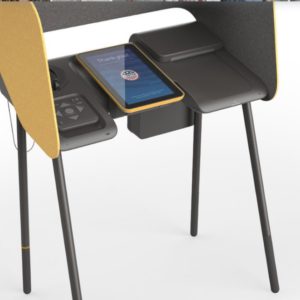There was a mock election in Los Angeles County this weekend put on by the county registrar-recorder’s office and I voted for the Hollywood sign as the most iconic L.A. landmark. The question about the best landmark was one of the 14 test questions included in the mock election for county residents to test out the new voting system that will be in place at vote centers around the county for the coming March 3 primary.
As someone who likes the idea of neighborhood voting places, I find vote centers placed around the county a foreign concept but I participated in the election to give the new equipment a try.
L.A. County Registrar-Recorder Dean Logan calls the change for the county’s 5.3 million voters “Voting Solutions for All People.”
The site I chose for the mock election was actually erected outside at a park basketball court and the opening of the facility was delayed over an hour because of a light drizzle that fell on that part of Los Angeles Saturday morning.
Ten new digital voting booths were set up under tent covers. A voter had to sign in on an electronic screen after the election official found your name among registered voters. Once that was accomplished a ballot was printed, but it wasn’t like any ballot I’d seen before. It was mostly a blank 8 ½ x 11 sheet of paper. What was printed was one of those QR code squares (QR for Quick Response) with the voter’s information miraculously scrambled inside the square.
The voter ID is necessary to make sure when the votes are counted one voter doesn’t go from vote center to vote center to cast ballots. Under the new system, a voter can vote at any vote center in the county.
The voter then goes to the digital ballot booth, which is wider than the old-fashioned voting booths. Rather than a booth it is a machine mounted on four legs with yellow sideboards (for privacy). The center of the contraption has a large iPad like device. To the left is a headset and controls that can provide verbal assistance. To the right of the pad is a flat place that acts like a serving tray where the QR imprinted sheet of paper goes. The paper is then sucked into the machine like a paper check at an ATM machine.
In the mock election, the voter was asked to vote on best parks, sports teams, landmarks etc. in the L.A. area. In March, candidates and ballot measures will fill the screen. The voter pushed buttons on the screen to cast the votes. There is an opportunity to review the vote before printing out the ballot. After checking the printed ballot, the voter places the ballot back on the serving tray area and once again the paper is sucked into the machine.
Your vote now has been cast.
County officials say the votes will only be tabulated according to what is on the paper ballot. The digital device is not connected to the Internet to protect against voter fraud.
The test run was looking for problems with the new set up. The electronics worked smoothly, but I did raise some concerns in a follow-up questioner.
- If a contested candidate race in the era of top-two primary has many candidates, it is doubtful all can fit on one iPad like screen. Presumably, the voter would use a button marked “More” to see all candidates. One of the questions in the mock election used the “More” button. Will all the voters see the “More” button? Candidates who head the list on the screen’s first page will have a distinct advantage.
- The printing of the ballot at sign-in seemed slow and could help to create a line build-up at the sign in table, although one hopes as the system is used more often and vote officials become more familiar with the procedure, the process moves more quickly.
- How many ballot sheets might be needed if there is an extraordinary long ballot?
- Despite the yellow sideboards surrounding the device, the large screen makes a secret ballot more vulnerable to prying eyes, depending on how the machines are configured at a particular polling place.
Finally, a cautious word to my friends in the newspaper world. The after mock election survey asked among other things about how the person participating in the trial learned about it. Television, radio, Internet and others items could be checked off. Newspapers were forgotten. I had to write newspaper under the category: “Other.”


